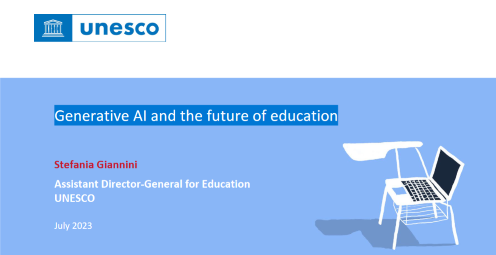
Generative AI and the Future of Education, by UNESCO Assistant Director-General for Education Stefania Giannini, explores the transformative impact of generative AI on educational paradigms, highlighting the challenges and opportunities it presents. She critically examines the role of AI in shaping language, knowledge and traditional constructs of education, highlighting the need for ethical considerations, inclusivity and a re-evaluation of educational goals in the AI era.
Giannini calls for a cautious approach to the integration of AI into education, advocating rigorous validation processes similar to those used for textbooks and educational materials to ensure that AI is aligned with educational goals and societal values.
- Discusses the transformative potential and challenges of generative AI in education.
- Underlines the need for ethical frameworks and inclusive policies for the integration of AI in education.
- Emphasises the need to re-evaluate traditional educational goals and methods in the light of AI advances.
- Stresses the importance of ensuring that AI tools are consistent with educational values and societal needs.
- Advocates a balanced approach that combines the benefits of AI with caution to ensure educational integrity.
- Calls for international collaboration in research and policy-making to harness the potential of AI responsibly.
In her paper, UNESCO’s Assistant Director-General for Education calls for a bold and cautious approach to AI in education: She argues that our education systems should define a path and establish norms for how we understand AI – and, by extension, how we allow it to influence us and our world. At the same time, Giannini points out that a more cautious approach to generative AI in education is a sensible course of action in the context of uncertainty, novelty and weak safety checks.
UNESCO encourages countries to prioritise the principles of inclusion, equity, quality and, most importantly, safety as they move towards using AI tools in education.
Read on to learn more: https://unesdoc.unesco.org/ark:/48223/pf0000385877
